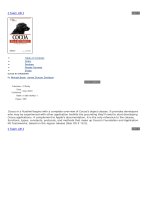Sams home wireless networking in a snap mar 2006 ISBN 0672327023
Bạn đang xem bản rút gọn của tài liệu. Xem và tải ngay bản đầy đủ của tài liệu tại đây (10.78 MB, 684 trang )
HomeWirelessNetworkinginaSnap
ByJoeHabraken
...............................................
Publisher:Sams
PubDate:March15,2006
PrintISBN-10:0-672-32702-3
PrintISBN-13:978-0-672-32702-5
Pages:408
TableofContents|Index
Thesedays,nobodyreallywantstolearneverythingthereisabouttheirhardwareand
software.Andevenifyoudid,whohasthetimetoendlesslytinkerandplaywithituntil
youfigureeverythingout?Youjustwantabookthatwillquicklyshowyouhowtosetup
yourhomewirelessnetwork.HomeWirelessNetworkinginaSnapisdesignedspecifically
forbusypeoplelikeyou.
Thisbookcoversthethingsthataren'talreadycoveredinthedocumentationthatcame
withyourequipmentandthethingsyoucan'tjustfigureoutonyourown.Itisorganized
intoaseriesofwell-organized,bite-sized,quicklyaccomplishedtasks,thatletsyouzero
rightinonparticulartasksyouwanttoaccomplish.Thishands-onapproachtosetting-up
asecurehomewirelessnetworkwillhaveyournetworkupandrunninginnotime.
HomeWirelessNetworkinginaSnap
ByJoeHabraken
...............................................
Publisher:Sams
PubDate:March15,2006
PrintISBN-10:0-672-32702-3
PrintISBN-13:978-0-672-32702-5
Pages:408
TableofContents|Index
Copyright
AbouttheAuthor
Acknowledgments
WeWanttoHearfromYou!
ReaderServices
PartI:NetworkingandWindowsFundamentals
Chapter1.StartHere
WhyCreateaWirelessHomeNetwork?
HowComputersCommunicate
HowWirelessNetworkingWorks
SelectingWirelessNetworkComponents
GettingtheMostOutofaHomeNetwork
SortingOutBroadbandInternetConnections
Chapter2.NavigatingWindowsXP
Section1.AbouttheWindowsXPEnvironment
Section2.NavigatetheWindowsDesktopandStartMenu
Section3.BrowseandSearchforFilesandFolders
Section4.AboutMyNetworkPlaces
Section5.UsetheControlPanel
Section6.ViewtheWindowsSecurityCenter
Section7.GetHelpinWindows
Section8.AboutWindowsUpdate
Section9.UseWindowsUpdate
Chapter3.SharingaHomeComputer
Section10.AboutSharingaWindowsXPComputer
Section11.CreateaUserAccount
Section12.ChangetheAccountPicture
Section13.PasswordProtectaUserAccount
Section14.ChangetheAccountType
Section15.Configurea.NETPassportforaUserAccount
Section16.LogOntoWindows
Section17.SwitchUsers
Section18.DeleteaUserAccount
PartII:CreatingtheHomeNetwork
Chapter4.InstallingandConfiguringtheWirelessRouter
Section19.AboutInstallingtheWirelessRouter
Section20.InstalltheRouter
Section21.AboutConfiguringtheWirelessRouter
Section22.AccessRouterConfiguration
Section23.AboutInternetSettings
Section24.ConfigureInternetSettings
Section25.AboutWirelessSettings
Section26.ConfigureRouterWirelessSettings
Chapter5.InstallingandConfiguringWirelessAdapters
Section27.AboutWirelessNetworkAdapters
Section28.DetermineUpgradeabilityofCurrentComputers
Section29.InstallaWirelessAdapter
Section30.InstallAdapterSoftwareUtility
Section31.CheckWiFiAdapterInstallation
Section32.AboutConfiguringtheWirelessAdapter
Section33.ConfigureAdapterandConnecttotheWirelessRouter
Section34.ConfigureAdapterforComputer-to-ComputerNetworking
Section35.CreateConfigurationProfiles
Section36.AboutUpdatinganAdapterDriver
Chapter6.ConfiguringtheWindowsHomeNetwork
Section37.AboutConfiguringPCsforNetworking
Section38.RuntheNetworkSetupWizard
Section39.NametheComputerandJoinaWorkgroup
Section40.OpenConnectionPropertiesandEnableClients,Protocols,and
Services
Section41.AddaNetworkClientorService
Section42.ConfigureTCP/IPSettings
Section43.CheckWiFiAdapterStatus
Section44.VerifyWorkgroupMembershipandAccessNetworkNeighborhood
PartIII:UsingtheHomeNetwork
Chapter7.SharingNetworkResources
Section45.AboutSharingNetworkResources
Section46.ShareaPrinter
Section47.ShareaFolder
Section48.AboutAccessingNetworkResources
Section49.AccessSharedFoldersandOpenSharedFiles
Section50.MapaNetworkDrive
Section51.ConnecttoaSharedPrinter
Section52.SearchforNetworkComputers
Section53.AddaNetworkPlace
Chapter8.FilteringContentandEnablingGameServices
Section54.AboutContentFilteringandOpeningPorts
Section55.BlockAccesstoWebsites
Section56.BlockAccesstoInternetServices
Section57.SetUpaFilterSchedule
Section58.ConfigurePortForwardingandPortTriggering
Chapter9.TakingAdvantageofWirelessHotSpots
Section59.AboutWirelessHotspots
Section60.UsetheWebtoLocateHotspots
Section61.DetectWiFiHotspotsandConnect
Section62.Fine-TuneHotspotConnectionParameters
Section63.AboutWardriving
PartIV:ProtectingandSecuringtheWirelessNetwork
Chapter10.ProtectingYourSystemandData
Section64.AboutBackingUpandRestoringData
Section65.UsetheWindowsBackupWizard
Section66.UseAdvancedBackupFeatures
Section67.RestoreBackedUpData
Section68.CreateaSystemRestorePoint
Section69.RestoretheSystem
Chapter11.SecuringtheWirelessNetwork
Section70.AboutBasicNetworkSecurity
Section71.AboutFirewalls
Section72.ConfigureRouterFirewallSettings
Section73.ChangeRouterPassword
Section74.BackUpRouterConfiguration
Section75.TurnOffServerSetIDs(SSIDs)Broadcasts
Section76.About802.11SecurityStrategies
Section77.ConfigureWiredEquivalentPrivacy(WEP)Security
Section78.ConfigureWiFiProtectedAccess(WPA)Security
Section79.AboutNetworkInterfaceMACAddresses
Section80.CreateaWiFiNetworkMACAccessList
Section81.ConfigureRemoteManagement
Chapter12.ProtectingtheWirelessNetwork
Section82.AboutMalware
Section83.InstallandUseAntivirusSoftware
Section84.UpdateAntivirusSoftware
Section85.ActivatetheWindowsXPSecurityCenter
Section86.AboutSpyware
Section87.InstallAntiSpyware
Section88.UseAntiSpyware
Section89.AboutSpamEmailandOutlookExpress
Section90.ConfigureOutlookExpressRules
Chapter13.TroubleshootingandMonitoringNetworkConnections
Section91.AboutNetworkConnectionProblems
Section92.ResetWiFiAdapter
Section93.CheckRouterStatus
Section94.ViewAttachedDevices
Section95.ViewRouterLog
Section96.AboutCommand-LineTools
Section97.UseCommand-LineTools
Section98.AboutUpgradingRouterFirmwareandAdapterDrivers
ContentsataGlance
KeyTerms
Index
Copyright
HomeWirelessNetworkinginaSnap
Copyright©2006bySamsPublishing
Allrightsreserved.Nopartofthisbookshallbereproduced,
storedinaretrievalsystem,ortransmittedbyanymeans,
electronic,mechanical,photocopying,recording,orotherwise,
withoutwrittenpermissionfromthepublisher.Nopatent
liabilityisassumedwithrespecttotheuseoftheinformation
containedherein.Althougheveryprecautionhasbeentakenin
thepreparationofthisbook,thepublisherandauthorassume
noresponsibilityforerrorsoromissions.Norisanyliability
assumedfordamagesresultingfromtheuseoftheinformation
containedherein.
LibraryofCongressCatalogCardNumber:2004092816
PrintedintheUnitedStatesofAmerica
FirstPrinting:March2006
090807064321
Trademarks
Alltermsmentionedinthisbookthatareknowntobe
trademarksorservicemarkshavebeenappropriately
capitalized.SamsPublishingcannotattesttotheaccuracyof
thisinformation.Useofaterminthisbookshouldnotbe
regardedasaffectingthevalidityofanytrademarkorservice
mark.
WarningandDisclaimer
Everyefforthasbeenmadetomakethisbookascompleteand
asaccurateaspossible,butnowarrantyorfitnessisimplied.
Theinformationprovidedisonan"asis"basis.Theauthorand
thepublishershallhaveneitherliabilitynorresponsibilitytoany
personorentitywithrespecttoanylossordamagesarising
fromtheinformationcontainedinthisbook.
BulkSales
SamsPublishingoffersexcellentdiscountsonthisbookwhen
orderedinquantityforbulkpurchasesorspecialsales.For
moreinformation,pleasecontact
U.S.CorporateandGovernmentSales
1-800-382-3419
ForsalesoutsideoftheU.S.,pleasecontact
InternationalSales
1-317-428-3341
AcquisitionsEditor
BetsyBrown
DevelopmentEditor
AliceMartinaSmith
ManagingEditor
CharlotteClapp
ProjectEditor
GeorgeNedeff
ProductionEditor
BenjaminBerg
Indexer
KenJohnson
TechnicalEditor
DallasG.Releford
PublishingCoordinator
VanessaEvans
InteriorDesigner
GaryAdair
CoverDesigner
GaryAdair
PageLayout
PatriciaRatcliff
MichelleMitchell
Dedication
TomywonderfulwifeKim,mybrotherPete,mysisterSue,and
ofcoursemymomanddad.
AbouttheAuthor
JoeHabrakenisabest-sellingauthorandinformation
technologyandnewmediaprofessionalwhohaswrittenmore
than25booksonnetworking,desktopoperatingsystems,and
computersoftwareapplicationssuchasMicrosoftOfficeand
OpenOffice.org.Joeservesasanassistantprofessoratthe
UniversityofNewEngland,whereheteachesavarietyof
informationtechnologyandcommunicationcourses.Hisrecent
booktitlesincludetheAbsoluteBeginner'sGuidetoNetworking
(FourthEdition),SkinningMicrosoftWindowsXP,andNovell
LinuxDesktop9User'sHandbook.
Acknowledgments
ItdefinitelytakesateamtocreateabookandIhaveanumber
ofpeopletothank.IwouldliketothankallthefolksatSams
whohadahandincreatingthisbook.Abigthankstomy
acquisitionseditor,BetsyBrown,whopulledtheeditorialteam
togetherforthisbookandmanagedthebook-creationprocess
frominitialideatopublishedmanuscript.Iwouldalsoliketo
thankDallasReleford,thetechnicaleditorontheproject,and
AliceMartinaSmith,thedevelopmenteditor.Alsoabigthanks
goesouttoVanessaEvansandBenBerg.Lastbutnotleast,I
wouldliketothanktheprojecteditor,GeorgeNedeff.AndifI've
forgottenanyoneelse:Thankyou!
WeWanttoHearfromYou!
Asthereaderofthisbook,youareourmostimportantcritic
andcommentator.Wevalueyouropinionandwanttoknow
whatwe'redoingright,whatwecoulddobetter,whatareas
you'dliketoseeuspublishin,andanyotherwordsofwisdom
you'rewillingtopassourway.
Youcanemailorwritemedirectlytoletmeknowwhatyoudid
ordidn'tlikeaboutthisbookaswellaswhatwecandotomake
ourbooksstronger.
PleasenotethatIcannothelpyouwithtechnicalproblems
relatedtothetopicofthisbook,andthatduetothehigh
volumeofmailIreceive,Imightnotbeabletoreplytoevery
message.
Whenyouwrite,pleasebesuretoincludethisbook'stitleand
authoraswellasyournameandphoneoremailaddress.Iwill
carefullyreviewyourcommentsandsharethemwiththeauthor
andeditorswhoworkedonthebook.
Email:
Mail:
MarkTaber
AssociatePublisher
SamsPublishing
800East96thStreet
Indianapolis,IN46240USA
ReaderServices
Visitourwebsiteandregisterthisbookat
www.samspublishing.com/registerforconvenientaccesstoany
updates,downloads,orerratathatmightbeavailableforthis
book.
PartI:NetworkingandWindowsFundamentals
InThisPart
CHAPTER1StartHere
CHAPTER2NavigatingWindowsXP
CHAPTER3SharingaHomeComputer
Chapter1.StartHere
Itiscertainlynotuncommontohavemultiplecomputersina
homeorsmalloffice.Andmosthomeandsmallofficeusers
havedealtwiththeproblemsofconnectingthesecomputersso
thattheycansharefilesandotherresourcessuchasprinters
andasinglehigh-speedInternetconnection.
Evidenceoftheseforaysintocomputerconnectivityisoften
quiteapparentintheformofnetworkwiresunderfootand
overhead.Abettersolutionisthecreationofawirelessnetwork
orWLAN(wirelesslocalareanetwork).Notonlydoyoudoaway
withmostnetworkcabling,youalsoplacean"intelligent"
device,awirelessrouter,toactastheintermediarybetween
yourwirelessnetworkandyourbroadbandInternetconnection.
Inthischapter,wetakealookathowcomputerscommunicate
andhowwirelessnetworkingactuallyworks.Wealsodiscuss
wirelessnetworkingcomponentsandhowyoucangetthemost
outofyourhomeorsmallofficewirelessnetwork.
WhyCreateaWirelessHomeNetwork?
Unlessyourhomeorsmallofficehasbeenhard-wiredfora
localareanetwork(meaningnetworkwiringinthewalls,wall
networkports,andacentralswitchorotherconnectivitydevice
inacloset),thereasontocreateawirelesshomenetworkis
fairlyselfevident.Andwhilemanyhomesandsmallofficesmay
havestartedoutwithonesharedcomputerthathadadial-up
Internetconnection,lower-costcomputersandtheavailability
ofextremelyfastbroadbandInternetconnectionsmakethe
creationofahomenetworkhighlydesirableandaffordable.
Wirelessnetworkingprovidesanexcellentalternativetowired
networksandprovidesenoughbandwidth(upto54Mbps)for
sharingprintersandfiles,andevengamingonthenetwork.
BecausetheWLANrequiresanaccesspointforthevarious
wireless-enabledcomputerstocommunicate,theaccesspoint
canconsistofawirelessrouterthatcanalsoserveasan
intermediarybetweentheWLANandabroadbandInternet
connection.Therouterallowsallthecomputersonthewireless
networktosharethesamehigh-speedInternetconnection.
KeyTerms
WLAN(wirelesslocalareanetwork)Anetworkthatis
limitedtoonelocalizedsite(thusthe"local"inthename).
AccesspointAhardwaredevicethatactsasthecentral
connectingpointforwireless-enableddevices.Accesspointscan
alsoprovideLANportssothatcomputersonthenetworkcanbe
connectedtotheaccesspointusingtraditionalnetworkcabling.
WiFirouterscontainaccesspointssothattheWiFi-enabled
computerscanaccessthenetworkandtakeadvantageofa
high-speedInternetconnectionwheretheWiFirouterservesas
theintermediarybetweenthehomenetworkandyourInternet
connection.
WLANsalsoprovideyouruserswithmobility,whichisinsharp
contrasttoawiredLAN.Userswithanotebookcomputerthatis
wireless-enabledcanroamanywhereinsideandoutsideofthe
homeorsmalloffice,justaslongastheystayinrangeofthe
wirelessaccesspoint(distancesofmorethan150feetandin
somecases300feetcanbeachieved).
ThecostsrelatedtocreatingaWLANareactuallyquite
reasonable,especiallywhereonlyafewcomputerswillbe
connected.Andmostnewnotebookcomputerscomewitha
wirelessnetworkadapteraspartofthebaseprice.
Note
Evenifyouhavealreadynetworkedyourhomeorsmalloffice
computersusingnetworkcabling,youmightwanttoclearaway
the"spaghettimess"ofcables.Andifyouhaveoldernetwork
connectivitydevicessuchashubsandnetworkadapters,
replacingthesedeviceswithnewerWLANdeviceswillactually
increasethedatarateonthenetwork.
Itdefinitelymakessensetogowirelessifyoualreadyhave
multiplecomputersinahomeorsmallofficethatarenot
networked.Asalreadymentioned,networkingallowsyouto
sharefiles,printers,andtheInternetconnection.Whenadding
computerstoyourhomeoroffice,youcertainlyshouldconsider
buyinganewcomputerwithawirelessnetworkadapter.
Evenifyoualreadyhavea"wired"homenetwork,youcanstill
goWiFiandaddnewcomputerstothenetworkbyoutfitting
themwithWiFinetworkadapters.BecausemostWiFirouters
alsoprovideswitchports,youcanconnectwiredcomputers
directlytotheWiFirouter.TheWiFi-enabledcomputersonthe
networkconnectusingradiowaves.So,whetheracomputeris
connectedbynetworkcablingorradiowavesdoesn'treally
matterintermsofthecomputertakingadvantageofthehighspeedInternetconnectionprovidedonthenetworkandthe
abilityofallthecomputerstoshareresourcessuchasfilesand
printers.
OnelastwordabouttakingadvantageofWiFinetworking:
AlthoughWiFinetworkingiseasytotakeadvantageof,thefact
thatyourdatatravelsonWiFiradiofrequenciesmeansthat
securitycanbeanissueforyournetwork.Otherpeoplecan
"listenin"onyourwirelesscommunicationsunlessyoutake
stepstosecureyournetwork.Itmakessensetousethe
securityfeaturesprovidedbyWiFi-enableddevicessuchas
wirelessrouters.FormoreinformationonWiFisecurity,see
AboutBasicNetworkSecurity.
HowComputersCommunicate
Beforewetakealookathowwirelessnetworkingactually
works,let'stakeaquicklookathowcomputerscommunicate
onanetwork.Forcomputerstocommunicateonanetwork,
theremustbeanetworkarchitectureinplacethatdictateshow
thedatamovesfromonecomputerandthenoverthewire(on
acabledLAN)orwirelesssignal(onaWLAN).
ThemostwidelyembracednetworkarchitectureisEthernet.
TheEthernetstandardsdefinehowanEthernetnetwork
adapter,Ethernetswitch,Ethernetaccesspoint,andother
Ethernetdevicestransmitdataonthenetwork.Data
transmissionspeedismeasuredinbitspersecond(bps).Abit
isonebinarydigit,eithera1ora0(itisthesmallestunitof
data;8bitsmakeupabyte).Ethernetprovidesdata
transmissionspeedsinexcessofamillionbitspersecond
(Mbps).Intermsofnetworking,bandwidthisconsideredthe
numberofbitsthatcanbesentacrossthenetworkmedium
(suchasthewiredorwirelessnetwork)atagiventime.So,the
termsdatatransmissionspeedandbandwidthareoftenused
interchangeably.
Note
Ethernetgotitsstartin1972attheXeroxPaloAltoResearch
Center(PARC).XeroxreleasedacommercialversionofEthernet
in1975thatprovidedatransmissionspeedof3Mbps.Ethernet
hasmaturedtothepointwheretodaywehavegigabitEthernet
thatprovidesahugeamountofbandwidth.WirelessEthernet
networkscanprovideupto54Mbpsofbandwidth,whichis
greaterthanwhatsomehard-wiredLANscandeliver.
Ethernetisapassive,wait-and-listennetworkarchitecture.
Computersmustcontendfortransmissiontimeonthenetwork
medium.Toreceivedata,computersjustsitandwait,listening
tothenetwork.Whentheysensethataparticulartransmission
ismeantforthem,theyreceiveitontheirnetworkadapter.
Ethernettakescareofthemovementofdataatthehardware
level.Butuserslikeusdealwithsoftware.Softwarethat
providesourmethodofcommunicationwiththecomputer's
hardware.Forourvariouscomputersoftwareapplicationsto
talkoverthenetwork,theremustbesomesoftwarestandards.
Thesestandardsarecommunicationprotocols.Aprotocolis
reallysoftwarecodethatprovidestherulesforhowcomputers
communicateovertheEthernethardware.
KeyTerm
ProtocolAsetofsoftwarerulesthatdictatehowcomputers
andotherdevicescommunicateoveranetworkarchitecture
suchasEthernet.
Theonlynetworkprotocolwereallyneedtodiscussisthe
TCP/IPnetworkprotocolstack(it'sastackbecauseitcontains
anumberofprotocolsthathavedifferentjobs).Aprotocolstack
suchasTCP/IPmustprovideanaddresssystemandalsotake
careofconvertingdatawecreateinoursoftwareapplicationsto
aformthatcanbemovedbyEthernethardwareasabit
stream.
KeyTerm
TCP/IP(TransmissionControlProtocol/Internet
Protocol)Thecommonlanguageforthenetworkingworld.
TCP/IPistheprotocolsuite(orstack)thatservesasthe
foundationforthemega-networkknownastheInternet.Nearly
allcomputeroperatingsystemsembraceTCP/IPastheirdefault
networkingprotocol.
Tomakealongstoryshort,TCP/IPtakescareofthedata
conversionprocessandalsoprovidestheaddressingsystemfor
computersandotherdevicesonthenetwork.Theaddressing
systemconsistsofIPaddresses.AuniqueIPaddressis
assignedtoeachdeviceonthenetwork.Eachpieceofdatasent
overthenetworkislabeledwiththeIPaddressesofthesending
deviceandthereceivingdevice,allowingforthemovementof
datafrompointAtopointB.
ComputersanddevicesonaTCP/IPnetworkcanhavetheirIP
addressesconfiguredmanuallyordynamically.Tomanually
configureacomputerwithastaticIPaddress(meaningan
addressthatneverchanges),youconfigurethecomputerwitha
uniqueIPaddressandanaccompanyingsubnetmask(the
subnetmaskhelpsothercomputersdeterminewhichpartofthe
addressisnetworkinformationandwhichpartisspecificdevice
information).
ThealternativetomanuallyconfiguringdeviceswithanIP
addressandsubnetmaskistouseaDHCP(DynamicHost
ConfigurationProtocol)serveronthenetwork.TheDHCPserver
leasesIPaddressestocomputersandotherdevicesonthe
network.Wirelessrouters(discussedinseveralchaptersinthis
book)canactasDHCPservers,soyouwon'thavetoassignIP
addressestoallthecomputersonyourwirelessnetworkthe
routerdoesthatautomaticallyandbehindthescenes.
InWindowsXP(boththeHomeandProfessionalversions),the
IPaddressisconfiguredintheInternetProtocol(TCP/IP)
Propertiesdialogbox.YoucaneitherconfigureaWindowsXP
computerwithastaticaddressorconfigureittoacceptanIP
addressfromaDHCPserveronthenetwork(suchasyour
wirelessrouter).
ComputersrunningWindowsXPcanbeconfiguredwithstaticIP
addressesorconfiguredtoacceptanIPaddressfromaDHCP
server.
Note
WediscussIPconfigurationandothernetworksettingsin
ConfigureTCP/IPSettings.
TCP/IPtakescareofnetworkcommunicationatthesoftware
level,andEthernettakescareofcommunicationatthe
hardwarelevel.ThewirelessstandardsusedforWLANsare
actuallyEthernetstandards.WediscusswirelessEthernetin
"UnderstandingWirelessNetworkingStandards,"laterinthis
chapter.
HowWirelessNetworkingWorks
Nowthatyouhaveafeelforhowcomputersandotherdevices
talkonanetwork,wecantakealookathowwireless
networkingactuallyworks.Wirelessnetworkconnectionstake
advantageofradiosignalsandinfraredlight(theseconnections
arelimitedinrange).WiFiconnectionsbetweenWiFi-enabled
computersandotherWiFidevicessuchaswirelessroutershave
amaximumrangeofaround300feet.
Note
Otherwirelessandlonger-distancecommunicationstrategies
(suchasthoseusedbycellphonesthattakeplacethrough
cellulartelephonetechnology)canprovidegreaterrange.Thisis
becauseacellphonecanconnecttoacellularantennathatis
milesawayfromthephone.SomeInternetserviceproviders
(thatalsohappentobecellularphonecompanies)suchas
VerizonandevenGooglearelookingattechnologythatoffersa
high-speedwirelessnetwork(whichisbeingcalledWiFibut
differsfromthehomeWiFiwearediscussinghere).Thiscellular
technologycanbeaccessedfromnearlyanywhereina
geographiclocation(suchasacity)andcanalsobeusedto
accesstheInternet.So,thephysicallywiredhigh-speed
InternetconnectionswetakeadvantageofthroughDSLand
cablemodemsmightbeslowlyreplacedbythisWiFi-on-steroids
technologythatisbeginningtorolloutinmajormetropolitan
areas.
Intermsofhomeandsmallofficenetworking,theEthernet
WLANhardwareavailabletakesadvantageofradioconnectivity.
Theequipmentoperatesinthepartofthefrequencyrangethat
theFCChasreservedforunregulateduse;youwillfindthat
wirelessLANsoperateinthe2.4GHzandhigherranges.
Note
Wirelessnetworkingequipmentoperatesinthesamefrequency
rangeasanaloganddigitalhometelephonesandotherdevices.
Theonlydifferencebetweena(wired)EthernetLANandan
EthernetWLANisthattheWLANsendsdataoverradiowaves
ratherthanthroughnetworkcables.AWLANisstillanEthernet
network,plainandsimple.However,wirelessEthernethasits
ownsetofstandardsthathavebeendevelopedbytheIEEE
(theInstituteofElectricalandElectronicsEngineers,a
worldwidestandardsorganization).Let'stakealookatthe
wirelessEthernetstandards.
UnderstandingWirelessNetworkingStandards
TheIEEEhascreatedasetofstandardsfornetworkingthatfall
undertheIEEE802specifications(aseriesofengineering
specificationsfordevices).ThestandardforwirelessEthernetis
designatedas802.11.Threetypesof802.11standardsare
currentlyinuseforwirelessnetworking:
Note
The802.11wirelessstandardsarealsooftenreferredtoas
WiFi.Youwilloftensee802.11hardwarelabeledas"WiFi
devices."It'snotadifferentwirelessstandard,justanickname.
802.11aThis802.11specificationcanprovideupto
54Mbpsofbandwidthandoperatesinthe5GHzbandofthe
usable(public)radiospectrum.802.11aisjuststartingto
makeitswayintothehomenetworkingmarketplace,and
wirelessequipmentvendorssuchasLinksyshavebegunto
rolloutproductsusingthisspecification.Oddlyenough,
WiFi802.11band802.11gwereavailableWiFistandards
before802.11awasimplemented.
802.11bThisspecificationprovidesupto11Mbpsof
throughputandoperatesinthe2.4GHzband.802.11bwas
thefirstwirelessEthernetspecificationavailable(in1999).
Thespeedofacomputerconnectedtoa802.11baccess
pointdecreasesthefurtherthecomputerisfromtheaccess
point.The802.11bstandarddoesnotprovidethetypeof
rangeyougetfrom802.11g.Adistanceof100feetormore
betweentheaccesspointandtheWiFi-enabledcomputer
typicallydoesnotprovideanadequatesignalstrength.
802.11gThisspecificationprovidesbandwidthbetween20
and54Mbpsinthe2.4GHzband.Itiscurrentlythefastest
growingimplementationofwirelessnetworkingforhome
networksandsmallLANs.Thisspecificationcanprovide
goodconnectionsbetweenaccesspointsandWiFi-enabled
computersthatareupto300feetapart.
Note
Youprobablywonderwhatthe802.11numberingisallaboutin
termsofthewirelessEthernetstandards.TheIEEEprovidesthe
specificationsforalltypesofnetworkingstandards.For
example,802.3isthespecificationforEthernetLANs(meaning
wiredLANs).









